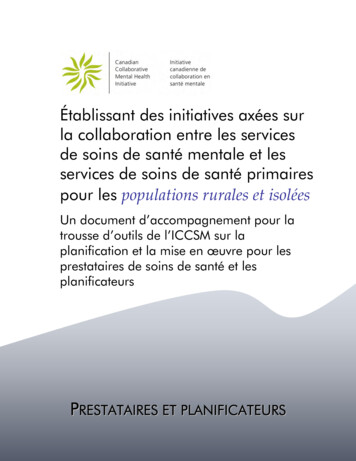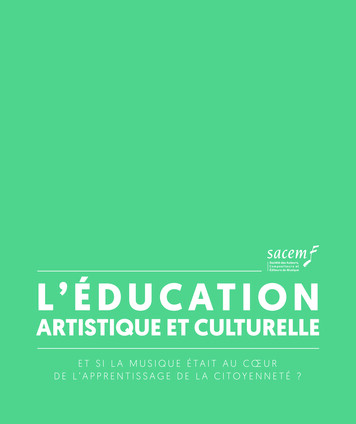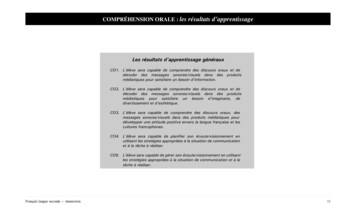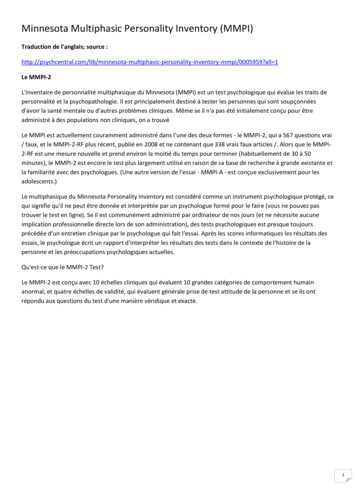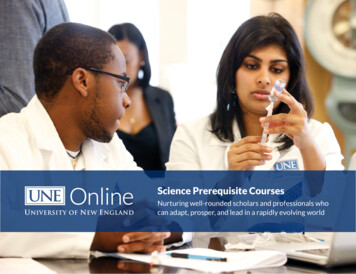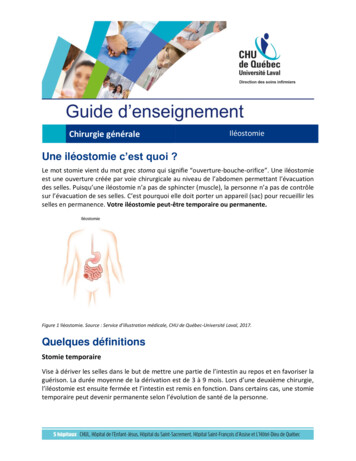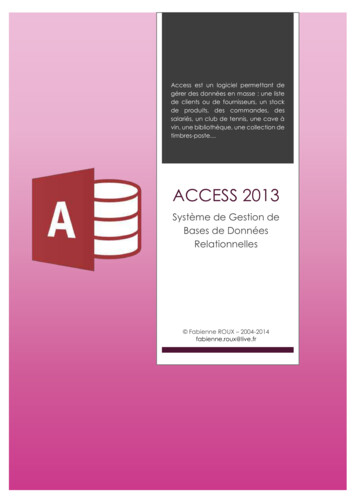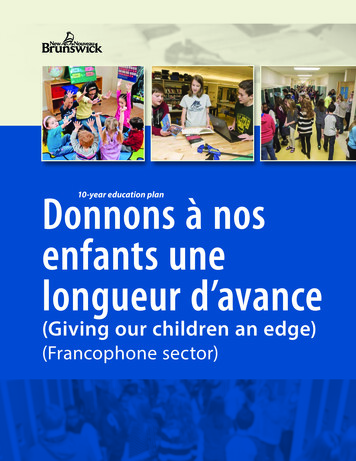
Transcription
Donnons à nosenfants unelongueur d’avance10-year education plan(Giving our children an edge)(Francophone sector)
10-Year Education Plan – Donnons à nos enfants une longueurd’avance (giving our children an edge)(Francophone Sector)Published by:Province of New BrunswickPO Box 6000Fredericton, NBE3B 5H1CanadaAugust 2016ISBN xxx (print edition)ISBN xxx (PDF: English)10781
Premier’s messageEducation is key to New Brunswick’s economic future and social fabric.It is for this reason that education is such a priority of New Brunswickers. Strengthening our economystarts by strengthening our education system. This is why we embarked together on a journey to developa strong and innovative long-term education plan.New Brunswickers have told us that we need to change the way we deliver early learning and educationto improve our performance and better prepare our young people for success. We’re listening. The plan,Donnons à nos enfants une longueur d’avance (giving our children an edge) focuses on setting objectivesin key priority areas using a performance management system so that we can create lifelong learnersand bring stability to our system.This plan is different in that it is non-partisan, long-term, and focuses on defining our challenges and theoutcomes needed to overcome them. The plan establishes clear expectations on standards and performance, with outcome measures that will be tracked and reported. Measurement of key outcomes allowsus to monitor our progress across the next ten years.We should be proud that for the first time, an education plan has been built on an extensive public consultation. Many participated including experts, First Nations, school and school district personnel, earlylearning educators, youth, parents, community and business leaders, district education councils andother key partners through a series of open houses, one-on-one meetings, workshops and opportunitiesto comment online.It is also important to mention the considerable influence of the Linguistic and Cultural Development Policy on the 10-year education plan. Various strategies put forward in the policy are reflected in this plan.We want to thank all of the participants who participated in this process. Thank you for your passiontowards education and New Brunswick.We are all invested in the implementation of the plan, Donnons à nos enfants une longueur d’avance,and it is by working together that we can leave the next generation the precious gift of a robust andforward-thinking education system.Brian Gallant1 10-year education plan
Minister’s messageThis 10-year education plan, Donnons à nos enfants une longueur d’avance (giving our children an edge),forges a new path forward for education in New Brunswick. We want New Brunswickers to begin learning at birth and to continue learning throughout their lives. This will be achieved through the prioritiesand conditions for success identified in the following pages.We are committed to a rising tide of excellence in New Brunswick’s education system. As the title ofthis plan suggests, to achieve our objectives we must give our children an edge. It’s what New Brunswickers expect and it’s what our children deserve. That means children and parents need to value andbe engaged in learning. We are also aware of the crucial role of teachers, educators, and other professionals in achieving the 10-year education plan and in the educational success and identity building ofchildren. Learners are not at their best unless educators are at their best. That’s why we are committedto supporting those working in our system so they can nurture their own personal excellence andcontinuous growth.Donnons à nos enfants une longueur d’avance would not be what it is without the considerable contribution of the Linguistic and Cultural Development Policy, which is founded on a massive collective effortduring the past few years, and is one of its main pillars. The plan is also the result of a wide public consultation led by co-chairs Gino LeBlanc and Karen Power, who put forth the excellent recommendationsupon which this plan is built, and who confirmed that we are all key stakeholders in education. Eachof us has a role to play in furthering the objectives of this plan including youth, parents, school andschool district personnel, educators, First Nations, community and business leaders, district educationcouncils and other key partners.I want to take this opportunity to thank the co-chairs for their work and also to thank all the membersof the public who participated in the extensive consultation process, showing that education is notonly a priority for our education system, but also for the entire population.This is a very exciting time in early learning and education and I look forward to working with ourpartners to put this plan into action beginning with the upcoming school year.Minister of Education and Early Childhood DevelopmentBrian Kenny2 Everyone at their best
IntroductionNew Brunswick’s children and youth live in a continuallyevolving knowledge-based society. To have a rewardingand successful life, young people need skills that will helpthem be fulfilled, engaged citizens. To develop these skills,they need an education system that evolves at their ownpace and meets their needs, while adapting to changes insociety, and a learning culture valued by everyone wherechildren and adults remain active learners.It is important to note that we understand an educationsystem to mean a system that unifies learning for childrenfrom birth, as well as education for students in publicschools who then make the transition to post-secondaryeducation or the labour market. This learning continuumprinciple is an integral part of the 10year plan.The development of this 10-year education plan is theresult of extensive consultations involving youth, parents,teachers, early childhood educators, as well as communitypartners in various linguistic and cultural communities.This exercise, in which representatives of various politicalparties also participated, gave all citizens an opportunity toprovide input on the future of education in New Brunswick.Through this transparent, nonpartisan approach, participants reached a common conclusion: lifelong learning isvitally important for New Brunswick society.Another finding that emerged during this engagementprocess was that the education system requires a clearvision and greater stability to ensure the optimum overalldevelopment of every child, starting in early childhood allalong the pathway through school and post-secondaryeducation.The 10-year education plan is intended to be a social contract that will ensure all partners in the system are headingin the same direction and working closely together toachieve the objectives stemming from a shared vision.Lastly, for the plan to be successfully implemented, it willbe necessary to strike a balance between flexibility andempowerment, which encourage innovation and generaterenewed energy within the system, and accountabilityreporting and continuous improvement. To achieve thatbalance, a structured management approach will makeit possible to carry out and monitor various initiativesarising from the plan.It will also be necessary to create conditions that foster astimulating and rewarding learning environment where everyone can continually grow each and every day. We mustsupport these environments so that best practices andsuccessful methods can be easily developed and shared.3 10-year education plan
BackgroundLinguistic and Cultural Development Policy (LCDP)The Linguistic and Cultural Development Policy (LCDP), published by the Department of Education and Early Childhood Development in 2014, is undoubtedly one of thefundamental components of the 10-year education plan.It is impossible to overlook and not acknowledge the immense effort devoted to engaging the many partners ofthe Acadian education system in order to identify concretesolutions for addressing the many challenges associatedwith French education in linguistic minority communities.There is no denying that the achievement of the dual mission of the Acadian and Francophone education systemlargely depends on the implementation of all the strategiesoutlined in the LCDP.If the major objectives of the education plan derive directly from the recommendations in the report Miser surl’éducation : apprenante et apprenant pour la vie (Focus oneducation: learners for life) (2016), it is important to stressthat the objectives were widely drafted taking into accountthe strategies and courses of action already identified inthe LCDP. Therefore, the majority of strategies are directlyor indirectly touched on in this education plan, either interms of the key objectives or the conditions for success.The work involved in engaging the many partners of theAcadian and Francophone education system, which resulted in the LCDP, must continue to help the system achievethe objectives in the education plan. The individual andgroup action plans that were developed and continue to bedeveloped by education partners to implement the LCDPwill certainly support personnel in their efforts to foster thesuccess of all learners. Therefore, the LCDP serves as thebackdrop for the provincial education plan, and togetherthey form a whole and complement one another.Graduate profileThe Profil de sortie d’un élève du système acadien et francophone du Nouveau-Brunswick (New Brunswick Acadianand Francophone school system graduate profile), whichwas developed following a series of consultations withkey partners, is another fundamental component of theprovincial education plan. The plan’s eight key objectivesare grouped under three major educational goals, as setout in the profile: Living a balanced life; Living as engaged and ethical citizens; Developing a desire for lifelong learning.The three major goals set by the Department of Educationand Early Childhood Development serve as a foundation forthe inclusive vision of the Francophone education system inNew Brunswick. They also reflect the dual mission and takeinto account all of the complexity and interdependence ofthe environments in which learners thrive.The graduate profile promotes a competency-based approach that allows students to operate in various learningand life contexts. The following three competencies, whichwill develop interdependently throughout the educationaljourney, have been identified: socio-emotional competency; cognitive competency; communication competency.The main objectives of the plan were developed by takinginto account these three competencies and the changesneeded within the education system to ensure that learnersare more engaged in their learning all along the continuumand have truly acquired these competencies when theyleave high school.Diversity and respectFor nearly 30 years, the New Brunswick education systemhas adhered to the philosophy of inclusive education. In thebeginning, the emphasis was on integration, which primarilyconsists of placing children with special needs in schools.Over the years, this has evolved into inclusive education,a philosophy involving teaching practices that support allstudents within a common learning environment.The 10-year education plan still embraces the principles ofinclusion as they are the foundation for New Brunswick’ssociety. Nowadays, inclusive education is based on respectfor diversity, as well as on the principle that every child andstudent is able to learn. Inclusive education takes place inlearning environments that ensure the wellbeing of andprovide quality teaching for all participants.The goals of the education system take respect and diversityinto account and apply to all students. It is therefore important to provide them with a flexible but challenging learningenvironment that includes a continuum of programs andservices that are provided in both a universal and personalized way. Therefore, the teaching of curricula, supportservices and extracurricular activities are provided equitablyto all learners. It is in that sense that all of the objectivesset out in the plan take inclusive principles into account.4 Everyone at their best
VisionEach person, from early childhood to adulthood, develops and realizes his or her full potential. As an engaged citizenwho is open to the world, she or he contributes to the vitality, the development and the influence of the Acadian andFrancophone community and New Brunswick society. (LCDP, p. 22)MissionThe Acadian and Francophone education system provides each person, from early childhood to adulthood, with qualityeducation contributing to his or her educational success and to the development of his or her linguistic and culturalidentity. (LCDP, p. 23)Systemic condition for changeResearch shows that 70 per cent of organizational changeinitiatives fail despite the best intentions (Blanchard, 2010).In fact, many fail because organizations do not establishstructured processes to lead the desired changes, anddo not prioritize activities, monitor outcomes or supportimprovements made over time. Setting up a formal management system is a proven structured approach thatenables organizations to address these challenges.In that regard, a Formal Management system will be usedthroughout the education system to enable leaders andstaff to implement the 10year plan, drive improvementsand achieve desired outcomes to enable New Brunswick tobecome a world leader in education and early childhooddevelopment.5 10-year education plan
Objectives and conditions for successOrganization of the 10-year planGiven that learners are the focal point of the Acadian andFrancophone education system, the key objectives of theeducation plan are centred on activity areas that are directlyrelated to those objectives. Consequently, the outcome ofall activities and initiatives stemming from the educationplan will continue to be the success of all learners in thefollowing eight areas: Career and life readiness;Wellness;Identity building;Citizenship education and diversity;First Nations;School and life readiness;Literacy;Numeracy and science, engineering and technology.For each objective, the plan describes the following: Reasons why the objective is important for learnersuccess; Indicators of success to ascertain whether the objectivehas been met; Key areas where we must take action to achieve theobjective and targets.The education plan intentionally does not outline howeach objective is to be achieved and how each associatedkey area is to be implemented by school districts, schoolsand early learning services. Instead, it clearly sets out expectations with respect to the objectives to be achievedcollaboratively. The plan concludes by highlighting theconditions for success based on a system perspectivethat must be strengthened to achieve the learnercentredobjectives. The conditions for success are: application of Formal Management principles;equal access to programs and services;recognition of parents as first educators;training and coaching for staff;establishment of an integrated learning continuum;access to appropriate infrastructure and informationand communication technologies.Implementation plan and accountability reportWe acknowledge that the publication of this plan is justthe beginning of the work to be done. In this context, it isclear that the real work consists in determining how theplan will be implemented. In fact, this will enable the planto stand out from its predecessors. By using Formal Management principles, tools and methods, the departmentwill draw up an implementation plan and a reportingframework to ensure the successful implementation of the10-year education plan. The implementation plan will bedeveloped with school districts and early learning services,and published each year. Progress toward achievement ofthe targets will also be made public every year.6 Everyone at their best
Living a balanced lifeObjective 1Career and life readiness–Ensure that all studentsdevelop the competencies they need to achievetheir career and life readiness planReason for this objectiveIn the 2015 Grade 12 Exit Survey (Department of Educationand Early Childhood Development, 2015), 56.7 per cent ofgraduates stated that their uncertainty about a choice ofcareer was an obstacle to pursuing their post-secondarystudies. This same survey also found that only 59 per centof students had had an opportunity to participate in careerexploration activities and that 61 per cent of students hadhad an opportunity to participate in career-focused activities while they were in school. Schools must thereforetake action to better prepare students for their future. Asstated in the LCDP:“To be equipped to deal with all these changes, studentsmust be able to acquire the knowledge, skills and attitudes necessary to carry through with their life/careerproject and their civic engagement, so as to advancetheir personal and vocational development.” (p. 128)The LCDP reminds us equally that “schools must continue totransform teaching and learning so as to support the development of sustainable skills as explicit learning objectives.” (p.129) Consequently, in addition to helping students discovertheir strengths and talents and to explore various career options, it is necessary to ensure they are engaged in school sothey can develop their entrepreneurial spirit, as well as thecompetencies they will need to adapt to the world aroundthem on both a personal and professional level.Student engagement at school certainly has an impact notonly on their future, but also on the quality of their everyday life, because school is the most prevalent part of theirdaily routine. A survey conducted with more than 90 middleschools and high schools across Canada found that only 37per cent of students surveyed felt intellectually engaged intheir language and mathematics courses (Willms, Friesen& Milton, 2009). This figure is alarming because it revealsthat the majority of students do not feel that their coursesmeet their needs. In response to this finding, it is imperativeto take a look at teaching practices and the current schoolstructure in order to ensure that all students, regardless oftheir strengths and their challenges, have an opportunityto engage in long-term learning they can use throughouttheir lives.How will we measure our progress?IndicatorActual20252026% of Grade 12 students who indicate theyare confident in their decisions regardingtheir transition to post-secondary education or the labour marketFall 2018*90%% of Grade 12 students who indicate theyhave developed the necessary skills tocarry out their career and life readinessplanFall 2018*90%% of Grade 8 students who indicate thattheir time in elementary school helpedthem identify their strengths and areasof interestFall 2018*90%*Baseline data and target, where applicable, will be established by Fall2018.Key areas Self-discovery: Provide all students, starting in elementary school, the tools to discover their strengths, thechallenges they face, what they feel passionate about,and their interests, so they are better equipped to makeinformed decisions about their future both on a personaland professional level. Competency-based approach: Provide all studentsopportunities to develop, all along their schooling, inlearning environments that foster a competency-basedapproach and allow students to carry out complex, meaningful and context-specific tasks. Varied range of courses: Provide all high school studentsopportunities to take compulsory and elective coursesthat meet their needs and are related to their career andlife readiness plan. Career exploration: Provide all students opportunities toregularly participate in activities where they can explorevarious careers in different areas, including careers intrades, computer programming and the arts.7 10-year education plan
Living a balanced lifeObjective 2Wellness–Ensure all learners develop the skills thatwill help them live fulfilling and healthy livesReason for this objectiveNurturing secure and stable emotional bonds in youngchildren provides a permanent foundation with positive,longterm consequences. These bonds foster the development of selfconfidence, the ability to manage emotions, theability to adjust, as well as motivation to explore the worldaround them. A healthy lifestyle (physical exercise, propernutrition and good sleep habits), the four components ofmental health (autonomy, competence, relatedness andgenerosity), and prosocial behaviours are some of the keyelements for good physical and mental health.However, statistics show that there are significant deficiencies in this area. The New Brunswick Health Council statesin its report Recognizing and Focusing on Population HealthPriorities (2016) that New Brunswick is one of Canada’sleast healthy provinces. The Council also states that 16 percent of students in Grades 4 and 5 are at risk of developingmental health problems (2014).It is therefore important to establish conditions which willdevelop the skills required for good physical and mentalhealth.“When mental fitness needs are sufficiently met,people become more resilient and selfdetermined in adopting attitudes and behavioursthat contribute to their personal wellnessand that of others.” (New Brunswick HealthCouncil, 2013, p. 1)How will we measure our progress?20252026IndicatorActual% of preschoolers exhibiting a high levelof overall health according to educators inlicensed Francophone early learning andchild care centresFall 2018*% of preschoolers exhibiting prosocialbehavioursFall 2018*% of students in Grades 6 to 12 reporting ahigh level of mental fitness at school67%90%% of students in Grades 6 to 12 reportingvery good or excellent physical healthFall 2018*90%% of students in grades 6 to 12 reporting amedium or high level of resilience74%90%*Baseline data and target, where applicable, will be established by Fall2018.Key areas Active healthy lives: Provide all learners opportunitiesto participate in learning and life experiences that willhelp them adopt behaviours and develop the necessaryskills to lead active healthy lives. Mental health in the learning environment: Provideall learners the opportunity to participate in learningand life experiences that will help them develop mentalhealth components at school: autonomy, competence,relatedness and generosity. Healthy relationships: Provide all learners the opportunity to participate in learning and life experiences thatwill help them develop the necessary interpersonal skillsto adapt to various social situations.8 Everyone at their best
Living a balanced lifeObjective 3Identity-building–Incite all learners to build theiridentities and develop a sense of belonging tothe Acadian and Francophone communityReason for this objectiveIdentity building for every learner is the focal point of theAcadian and Francophone school system’s mission. It isalso a priority of the LCDP which devotes an entire sectionto it. In minority settings, it is vitally important to ensurethat all learners develop a strong sense of belonging tothe Acadian and Francophone community, as well as confidence in expressing themselves in French. According tothe 2015 Grade 12 Exit Survey (Department of Education andEarly Childhood Development, 2015), 33 per cent of Grade12 students found it easier to speak English than French,which means that efforts must continue to strengthenlearners’ positive relationships with the French language,especially in Anglo-dominant environments.“Identity building is in a way the cornerstone for anyactions to be taken to help “make a society,” and toensure the sustainability of the French languageand the transmission, enrichment and renewal ofAcadian and Francophone culture. That is why it isvital that it be treated with great importance fromearly childhood all through the educational process.”(LCDP, p. 69)How will we measure our progress?IndicatorActual20252026% of children in licensed Francophone earlylearning and child care centres who activelyparticipate in activities associated with theFrench language and with Acadian andFrancophone culture, arts and traditions inline with the curriculumFall 2018*95%% of Grade 8 students reporting a positiverelationship with the French languageFall 2018*90%% of Grade 12 students reporting a positiverelationship with the French languageFall 2018*90%% of Grade 8 students reporting a strongsense of belonging to the Acadian andFrancophone cultureFall 2018*90%% of Grade 12 students reporting a strongsense of belonging to the Acadian andFrancophone cultureFall 2018*90%*Baseline data and target, where applicable, will be established by Fall2018.Key areas Positive relationships with language and culture:Provide opportunities for all learners to participatein learning and recreational activities that foster thedevelopment of a positive relationship with the Frenchlanguage and with Acadian and Francophone culture. Expression of identity through the arts: Provide opportunities for all learners to use various art forms asan expression of their identity. Past and present contributions of the Acadian andFrancophone community: Provide opportunities for alllearners to acquire an understanding and appreciationof past and present contributions of New Brunswick’sAcadian and Francophone community to the provinceand the country.9 10-year education plan
Living as engaged and ethical citizensObjective 4Citizenship education and diversity–Encouragelearners to be open to diversity and to participatein the growth of their communityReason for this objectiveLearners are in daily contact with other children and youngpeople who are different from them physically, culturallyand socially, for religious reasons, or because of their abilityin school. In addition, they are exposed to opinions, valuesand visions of the world that are different from their own.In an inclusive education system, it is important that alllearners are welcoming and respectful. To this end, theymust learn in environments where diversity is recognizedand valued. They must also have learning experiences thatencourage them to use their critical thinking skills andbe aware of the diversity around them, in all its forms. Byunderstanding values and beliefs that are different fromtheir own, learners will be able to interact and collaboratewith others, as well as become involved socially to build astronger, more dynamic society. The LCDP states:“It is essential for the education system and the Acadian and Francophone community to ensure thatstudents acquire skills that allow them not only tomake a judgment with a minimum of prejudice orpreconceived ideas about various situations, butalso to propose solutions that are relevant, effectiveand respectful of all parties involved in the courseof remedying situations they view as problematic.”(LCDP, p. 130)Developing citizenship in learners will give them a betterunderstanding of the role of the individual as a memberof a social group, as well as interpersonal relationships,and relationships between individuals, the area wherethey live and their social institutions.How will we measure our progress?20252026IndicatorActual% of high school students reporting beingable to influence decisions within their schoolFall2018*80%% of Grade 8 students reporting being open todiversity in all its formsFall2018*100%% of Grade 12 students reporting being opento diversity in all its formsFall2018*100%*Baseline data and target, where applicable, will be established by Fall2018.Key areas Critical and creative thinking: Provide all learners opportunities to grow in a learning environment thatfosters the development of critical and creative thinking. Diversity: Encourage all learners to be open to othersand the world in a learning environment where diversityis recognized in all its forms as being essential to personal development and the growth of the community. Engagement in school life: Provide all students opportunities, during their schooling, to experience citizenshipin all its forms by contributing to school life and toschool operations. Citizen engagement: Provide all students, during theirschooling, opportunities to look at various issues so thatthey can initiate, carry out and manage projects thatwill fulfil real needs in their community and in society.10 Everyone at their best
Living as engaged and ethical citizensObjective 5First Nations–Ensure all students value and understandthe culture and history of First Nation People andsupport First Nation students’ identity buildingReason for this objectiveIntercultural understanding, empathy and mutual respectbetween Francophones, Anglophones and First Nation People can contribute to the well-being of the New Brunswickcommunity. Clearly, it is vitally important to implementstrategies to highlight the culture and history of FirstNations.Justice Murray Sinclair, who headed the Truth and Reconciliation Commission of Canada, stated that reconciliation is a question of training and respectful relations. It istherefore essential to implement strategies and measuresto promote reconciliation.“Reconciliation [ ] as they heal from the destructivelegacies of colonization [ ] must inspire Aboriginaland non-Aboriginal peoples to transform Canadiansociety so that our children and grandchildren canlive together in dignity, peace, and prosperity onthese lands we now share. [ ] Expanding public dialogue and action on reconciliation beyond residentialschools will be critical in the coming years. Althoughsome progress has been made, significant barriersto reconciliation remain.” (Truth and ReconciliationCommission of Canada, 2015, p. 8)How will we measure our progress?20252026IndicatorActual% of Grade 12 students reporting having an opportunity to study the history of Canada’s FirstNation People in class during their schoolingFall2018*90%% of First Nation students reporting a strongsense
The graduate profile promotes a competency-based ap-proach that allows students to operate in various learning and life contexts. The following three competencies, which will develop interdependently throughout the educational journey, have been identified: socio-emotional competency; cognitive competency; communication competency.


